Minor scales are an important part of music theory. When you hear the term minor scales, you may be led to believe that this set of scales is much less important than the grand collection of major scales. Or you may think the minor scales are only for sad, sappy songs.
But the truth is that the arrangements and tones (or note sounds) available in the minor scales — divided, according to composition, into the natural, harmonic, and melodic minor scales — can be much more flexible for a composer to use than the major scales alone.
Even though every type of minor scale contains a different set of notes, each type of scale is put together in a specific way. These specific patterns of intervals are what put the minor scales into their little niche. The minor scale degrees all have the same names as the ones in major, except the 7th degree, which is called the subtonic.
Each of the eight notes in a minor scale has a name:
1st note: Tonic
2nd note: Supertonic
3rd note: Mediant
4th note: Subdominant
5th note: Dominant
6th note: Submediant
7th note: Subtonic
8th note: Tonic
In the harmonic and melodic minor scales, the 7th degree is called the leading tone. In the melodic minor scale, the 6th degree is called the submediant.
Playing natural minor scales on piano and guitar
Natural minor scales follow the interval pattern of WHWWHWW, which translates into Whole step Half step Whole step Whole step Half step Whole step Whole step. The first note (and last) in the scale determines the scale name.
A natural minor scale is taken from the major scale of the same name, but with the 3rd, 6th, and 7th degrees lowered by one half step. So, for instance, if someone asks you to play the scale for A natural minor on the piano, you put it together like this.
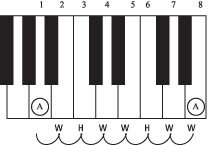
The same pattern also applies for each note up and down the guitar neck. Natural minor scales on the guitar follow the pattern shown below. Play the notes in the number order shown. Your first note is indicated by the 1 shown on the first E string.
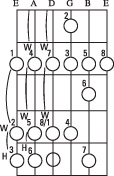
Just as with major scales, to play natural minor scales on the guitar, you simply move the pattern along the neck of the guitar to build whatever minor scale you’d like. Whatever note you start with on the top (low E) string is the tonic and therefore names the scale. If someone asks you to play an A minor scale on the guitar, for example, you play the pattern below.
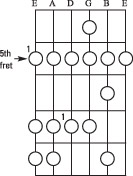
Having fun with harmonic minor scales on piano and guitar
The harmonic minor scale is a variation of the natural minor scale. It occurs when the 7th note of the natural minor scale is raised by a half step. The step is not raised in the key signature; instead, it’s raised through the use of accidentals (sharps, double sharps, or naturals).
To play the scale for A harmonic minor on the piano, you put the scale together as shown below. Notice how the piano scale changes when you add a half step to the 7th scale degree.

When you’re writing music and you want to use a harmonic scale, write it out using the natural minor key first, and then go back and add the accidental that raises the 7th degree up a half step.
Playing harmonic minor scales on the guitar is simple. You just position the pattern shown below over the root (tonic) position that you want to play in. Move it around to a different root to play the scale for that note.
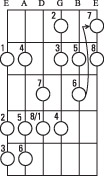
As always, the key is determined by the first and last notes of the scale, so if someone asks you to play an A harmonic minor scale on the guitar, you play this.
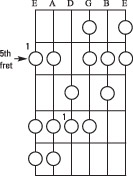
Making great music with melodic minor scales on piano and guitar
The melodic minor scale is derived from the natural minor scale. In the melodic minor scale, the 6th and 7th notes of the natural minor scale are each raised by one half step when going up the scale. However, keep in mind that they return to the natural minor when going down the scale.
While you’re going up in pitch when playing a piece, you raise the 6th and 7th degrees of the natural minor scale a half step, but during parts of the same piece where the pitch goes down, you play the notes according to the natural minor scale. Scales in which the 6th and 7th degrees are flat in natural minor require naturals to raise those two degrees.
To play an A melodic minor scale ascending (going up) the piano, you play what’s shown below. Notice how the piano scale changes when you add a half step to both the 6th and 7th degrees.
When writing music in the melodic minor scale, composers write out the song using the natural minor pattern, and then they add the accidentals that modify any ascending 6th and 7th notes afterward.
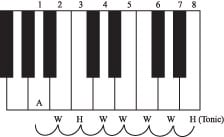
The wonderful thing about the guitar is that you have to memorize only one pattern for each type of scale and you’re set. To play the ascending A melodic minor scale on guitar, play this pattern.
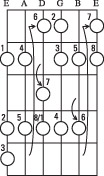
To play an A melodic minor scale ascending on the guitar, you play it like this.
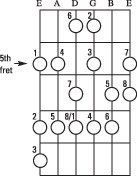
And, of course, for the descending notes on both the piano and guitar you revert to A natural minor.

